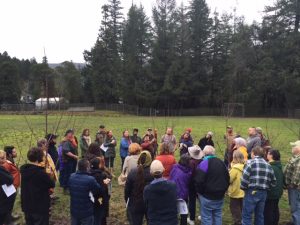
MKWC pruning workshop with Food Policy Council for Del Norte and Adjacent Tribal Lands. DNATL photo.
Mark Dupont of Mid Klamath Watershed Council (MKWC) has put together a beautiful how-to manual on the care of neglected fruit trees, based on MKWC, the Karuk Tribe, and the Salmon River Restoration Council‘s five years of collaborative work to restore local orchards as part of the Food Security Project. Here’s a preview:
Orchard Revitalization and Heirloom Fruit of the Klamath and Salmon Rivers: Preserving the Past, Securing the Future
Introduction
You’ve probably seen them, on the edge of the woods, or in a clearing that was once a homestead. Old fruit trees blend into the surroundings – they’re hardly noticeable until they’re covered in blossoms in spring, or heavy with fruit in the fall. They stand quietly year after year, with no care or tending, no pruning, irrigation, or fertilization. Yet somehow they survive, and even thrive, producing fruit year after year. They’ve become part of the landscape, and each has a story to tell: of a great grandfather who managed to obtain a seedling or a graft from some faraway place, of a family that planted and tended the orchard, of kids who grew up in the shade of the trees and picked and ate the fruit through the summer and fall.
These old legacy trees are not only part of the past; they are an important part of a bioregional food system, vital for the present and the future. They have survived years of drought, heavy winter snow and freezing, heat waves, and intense storms. Those still standing and producing have proven to be well-adapted to their habitat’s specific soils, pests and microclimate, and they produce food with little or no extra water and care. Many of these trees are unique, one-of a- kind plants, and nearing the end of their lifespans. Once they are gone they can never be retrieved.
Since 2012, the Karuk Tribe Department of Natural Resources (KDNR), the Mid Klamath Watershed Council (MKWC), and the Salmon River Restoration Council (SRRC) have collaborated to revitalize these long-standing orchard sites and save these heirloom tree varieties for future generations. Technicians from KDNR and SRRC have mapped old orchard sites, making baseline resource assessments, and regenerating conventional and cultural resources through restorative pruning and clearing blackberries and other competing vegetation. Field crews from all three organizations have identified the most promising trees with permanent markers and cataloged fruit by photographing and recording detailed descriptions. Through a series of workshops, community members have learned how to restore their own orchards through regenerative pruning, top working trees with heirloom varieties, and how to graft their own seedling fruit trees. Project partners have grafted approximately two hundred seedling trees to be planted in the community; and the Salmon River Restoration Council will be planting a Community Heirloom Orchard in the town of Forks of Salmon. MKWC purchased a community apple press which now circulates extensively within the river communities, making cider from hundreds of pounds of apples that were previously underutilized.
This publication aims to inform our local river communities, and beyond, of the work that has been accomplished in revitalizing local orchards and saving heirloom varieties, and provide inspiration and resources for continuing these efforts.
Hard copies of the full manual will be available soon at MKWC and the Karuk Department of Natural Resources in Orleans, CA, and online at the MKWC Foodsheds website.